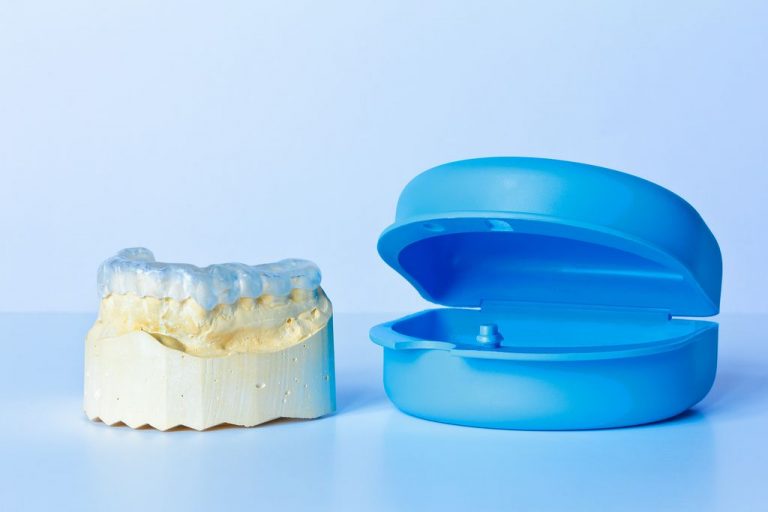Dental mouthguards may be worn to prevent patients from grinding or clenching their teeth. They are also used to help with sleep apnea symptoms and to protect teeth from injury during sports. At Definitive Dental in Grand Prairie, we work with patients who have concerns about protecting their teeth, and part of our evaluation process is to determine if patients may benefit from a mouthguard.
As with any device, it is important to understand how to clean a mouthguard after each use. Taking care of your mouthguard is important to ensure that the guard continues to protect your teeth properly. We recommend that patients who are learning how to clean a mouthguard simply add their guards to their daily oral hygiene routines at home.
Why You Need a Mouthguard
Before going over how to clean a mouthguard, let’s dive into why you might need a mouthguard in the first place. Your dentist may recommend that you wear a mouthguard in one of several situations.
Playing Sports
When you play contact sports, your risk of falling and injuring your face is high. For this reason, your dentist may recommend that you wear a mouthguard while engaging in athletic activities.
It’s not just about protecting your teeth — a mouthguard keeps you from accidentally biting your tongue or lip if your head suddenly jerks forward.
Sleep Apnea
You might also be a good candidate for a mouthguard if you experience sleep apnea. This potentially dangerous sleep disorder may cause you to stop breathing temporarily while you’re asleep. This may prevent the brain from getting an adequate amount of oxygen, which will increase your chance of experiencing a stroke or heart disease. It may also lead to excessive snoring. As a result, you might feel groggy the following day.
However, a mouthguard will push your tongue and lower jaw forward, therefore keeping the airway open. This will help you to resolve your sleep apnea problem.
Grinding Teeth
You may also need a mouthguard if you have bruxism, a condition where you clench and grind your teeth while sleeping. Grinding can cause several problems, including sore gums, tooth pain, and jaw pain. It can additionally damage the teeth.
When you wear a mouthguard, the guard will keep your bottom and top teeth separated. This will prevent them from damaging each other when you are clenching or grinding.
Do You Need to Clean Your Mouthguard?
Yes. Much like toothbrushes, mouthguards may retain food debris and bacterial plaque. Because a mouthguard is porous, it provides excellent places for bacteria to hide. This is why it is important to learn how to clean a mouthguard.
As a general rule of thumb, you should rinse your mouthguard immediately after each use with warm or cool water. This helps to loosen up any bacteria or plaque that may have built up while you were wearing the device. Avoid using hot water to rinse the mouthguard, as it could distort its shape.
Then, you should clean it once a day and deep-clean the mouthguard once per week. If you don’t clean your mouthguard, you face a greater risk of infection and gum disease.
How to Clean a Mouthguard at Home
Step 1
Gently brush your mouthguard using water and a toothbrush with soft bristles. A separate toothbrush can be used for this process if you prefer not to use the brush used for your teeth. When you clean a mouthguard, avoid using toothpaste. This can be too abrasive and could damage the mouthguard.
Step 2
The next step in keeping a mouthguard clean involves using mouthwash to further clean your mouthguard. By submerging it in mouthwash, you’ll kill any germs remaining on the mouthguard. Afterward, rinse the mouthguard using cool water. Avoid soaking the mouthguard in the mouthwash overnight as this may damage it.
Step 3
Set the clean mouthguard on a clean surface, and allow it to dry completely. If you do not let your mouthguard dry completely bacteria growth may occur. Typically, the drying process takes between 15-30 minutes.
Step 4
Once the mouthguard is dry, store the guard in a case. This step is necessary to keep a mouthguard clean and protect it from any damage. It may be best to store the mouthguard outside of the bathroom to ensure that the humidity or steam does not cause the mouthguard to warp over time.
Step 5
In addition to learning how to clean a mouthguard itself, keep in mind that cleaning the mouthguard case is also an important step in keeping a mouthguard clean. Cases should be hand-washed every couple of days before newly cleaned guards are placed in them to remove any bacteria that have collected over time.
Deep Cleaning Your Mouthguard
Dr. Peter Guirguis, our dentist in Grand Prairie, recommends that to further keep a mouthguard clean, a patient should deep-clean their mouthguard at least once a week. If you’re wondering how to deep-clean a mouthguard, note that patients can use a denture cleaner from your local pharmacy, use mouthwash mixed with water, or mix vinegar and hydrogen peroxide. Place the mouthguard in a bowl, and let it soak in the mixture of your choice for at least 30 minutes.
Once the mouthguard has soaked, you can remove it, and allow it to dry completely before placing it back in the case.
When to Replace Your Mouthguard
In addition to learning how to clean a mouthguard, you should get into the habit of replacing your mouthguard every 6-12 months. You’ll be able to tell that your mouthguard is worn out once it begins to feel different in the mouth or feels uncomfortable. This is because the constant biting impacts your mouthguard’s fit and shape over time.
When you visit our dental office in Grand Prairie, always bring your mouthguard and case. This gives our doctor the ability to inspect your mouthguard and ensure that the guard still fits properly. Our team can also help you to clean the guard if necessary during your appointment. Keeping a mouthguard clean is easy if you incorporate the cleaning process into your oral hygiene routine at home.
Learn How to Clean a Mouthguard and Keep Your Teeth Healthy at Definitive Dental
At Definitive Dental, we take pride in offering top-tier dental treatments in Grand Prairie. In addition to showing you how to clean a mouthguard, we’re ready to examine and clean your teeth regularly to keep them in the best shape possible. We can also treat any dental issues you may be experiencing, such as cavities before they grow into bigger problems.
Known for dentistry done right, our team at Definitive Dental is here to give you all of the options available to achieve that bright white smile. We welcome all patients, and we strive to always provide quality service that our patients can count on.
If you are interested in finding out more about mouthguards or are looking to get other dental restorations in Grand Prairie, please contact Dr. Peter Guirguis to schedule your consultation. Text us at (972) 646-0660, or use this contact form, and we’ll be happy to assist you!
Frequently Asked Questions
- Can I boil a mouthguard?
It’s common to boil a pacifier to sterilize it, but we don’t recommend this method to clean a mouthguard. The hot water can distort the mouthguard’s shape so that it no longer fits.
- Can a mouthguard cause cavities?
Not directly — if you keep a mouthguard clean, it won’t cause you any oral health issues. However, if you do not care for the mouthguard properly, the guard may contribute to cavity development. That’s because your guard can trap bacteria against your teeth, and if your teeth are exposed to the bacteria for long periods, you run the risk of developing cavities.
- Can I share a mouthguard with siblings who play sports?
No. Never share mouthguards, as you’ll essentially be sharing food debris and bacteria with your siblings. In addition, if one person is sick, anyone else who uses their mouthguard may develop the same illness. We highly recommend that siblings who both have mouthguards use different colored cases so they do not confuse their guards accidentally.
- Can I wear a mouthguard with braces?
Yes. It’s best to wear a guard over braces to protect this orthodontic appliance. Your mouthguard will also protect your mouth’s soft tissue from damage or injury if you have an accident while wearing braces.
- Can you clean a mouthguard using soap?
Absolutely. If you’re curious about how to clean a mouthguard with soap, note that you can use dish soap or antibacterial soap to get the job done. You’ll first want to rinse your guard with cool or lukewarm water, then apply a little soap to it. Afterward, brush your guard until you have cleaned each spot. Then, rinse the guard to get rid of the soap, and allow the mouthguard to dry.








